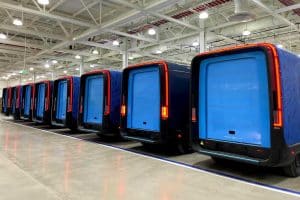- 🚗 Tesla will focus on using its existing gigacasting technology involving front and rear megacasts and a structural battery pack, instead of pursuing a single-piece gigacast for the underbody.
- ⚙️ Developing a single-piece gigacast would require significant investment and resources, including the need for an extremely large Giga Press machine.
- 🕰️ Tesla aims to accelerate the launch of new models, including more affordable ones, by combining aspects of its current platform and its next-generation platform.
- 📈 The new vehicles will be produced on Tesla’s current manufacturing lines more efficiently, without the need for new factories or massive new production lines.
- 🗣️ Elon Musk mentioned these plans during Tesla’s Q1 earnings call, suggesting that Reuters’ report may have been based on incomplete information.
- 🌐 The decision aligns with Tesla’s approach of focusing on tried and tested technologies for the Robotaxi “Cybercab,” which will be built on a new platform.
Amidst the rapidly evolving landscape of electric vehicle (EV) manufacturing, Tesla continues to navigate its course with a strategic blend of innovation and pragmatism. According to recent reports, the company has decided to focus on its existing gigacasting technology, involving front and rear megacasts and a structural battery pack, rather than pursuing a single-piece gigacast for the underbody.
The Practicality of Proven Technologies
While the idea of a single-piece gigacast for the vehicle underbody may have seemed enticing, Tesla’s decision to stick with its tried-and-tested gigacasting methods is rooted in practicality. Developing a single-piece gigacast would require a significant investment of resources and capital, including the need for an extraordinarily large Giga Press machine – a undertaking that could potentially strain the company’s finances.
Moreover, the current gigacasting process has already proven its worth in terms of efficiency and cost-effectiveness, making it a logical choice for Tesla as it accelerates the launch of new models.
Accelerating New Model Launches
One of the key drivers behind Tesla’s decision is the company’s goal to bring new models, including more affordable options, to market faster. By combining aspects of its current platform with elements of its next-generation platform, Tesla aims to streamline the production process and leverage its existing manufacturing lines more efficiently.
Elon Musk, Tesla’s CEO, addressed this strategy during the company’s Q1 earnings call, underscoring the importance of accelerating new model launches without the need for massive new production lines or additional factories. This approach not only enables Tesla to respond to market demands swiftly but also aligns with the company’s commitment to sustainability by maximizing the use of existing resources.
Focused Innovation for the Robotaxi “Cybercab”
While Tesla’s decision to prioritize its current gigacasting technology may seem like a step back from the cutting edge, it is an intentional move aimed at ensuring the successful launch of the highly anticipated Robotaxi “Cybercab.” As a vehicle built on a new platform, the Robotaxi represents a significant milestone in Tesla’s journey toward autonomous driving and shared mobility.
By focusing on tried and tested technologies for the Robotaxi’s production, Tesla can allocate its resources and innovative efforts towards refining the vehicle’s autonomous capabilities and advancing its next-generation platform for future models.
A Balanced Approach to Sustainable Growth
Tesla’s decision to leverage its existing gigacasting technology while incorporating aspects of its next-generation platform is a testament to the company’s balanced approach to sustainable growth. By capitalizing on proven manufacturing methods and optimizing resource utilization, Tesla can maintain its position as a leader in the EV industry while simultaneously laying the groundwork for future innovations.
As the world transitions towards a more sustainable future, Tesla’s pragmatic approach to manufacturing and its commitment to affordable EV options could play a pivotal role in accelerating the adoption of electric vehicles on a global scale.





